Introduction
Maintaining a clear, unobstructed view of the road is vital when driving, and your windshield washer reservoir plays an essential role in that. This article offers an insight into what the windshield washer reservoir is, how to know when it’s faulty, and the cost of replacing it in Canada.
What is a Windshield Washer Reservoir?
A windshield washer reservoir is a simple, yet crucial part of your vehicle. It is a container that holds the washer fluid used by your vehicle’s windshield washer system. When you activate the washer system, fluid from the reservoir is pumped onto your windshield, helping to clean and improve visibility.

How Much Will it Cost to Replace a Windshield Washer Reservoir in Canada?
In Canada, the cost to replace a windshield washer reservoir can vary widely, largely depending on the make and model of your vehicle. Here’s a general idea:
• Parts: A new windshield washer reservoir typically costs between CAD $50 and CAD $150.
• Labor: Mechanics typically charge around CAD $70 to CAD $100 per hour. Given that the replacement usually takes about one to two hours, you can expect to pay between CAD $70 and CAD $200 for labor.
• Total: Overall, you should expect to pay somewhere between CAD $120 and CAD $350 for the entire replacement process.
What are the Symptoms of a Faulty Windshield Washer Reservoir?
Symptoms of a faulty windshield washer reservoir can include:
• Leaking Fluid: If you notice washer fluid pooling beneath your vehicle or your reservoir empties quickly, it could be a sign of a crack or hole in the reservoir.
• Ineffective Cleaning: If you activate your windshield washers and the fluid doesn’t effectively clean your windshield, there may be a blockage in the reservoir preventing fluid from reaching the nozzles.
• Low Fluid Warning Light: Some vehicles have a low fluid warning light that will illuminate if the fluid level drops too low. This could be due to a leak in the reservoir.
• Visible Damage: Cracks, warping or discoloration on the reservoir itself could be signs of damage and possible leaking.
• Washer Fluid Not Spraying: If the washer fluid isn’t spraying at all when you activate the system, it could be a sign that the reservoir is empty or there is a problem with the pump.
How Long Does a Windshield Washer Reservoir Last?
The lifespan of a windshield washer reservoir is typically as long as the vehicle itself. They are designed to last and often only need to be replaced if they become damaged or start to leak.
How Does a Windshield Washer Reservoir Become Defective?
A windshield washer reservoir can become defective due to several reasons:
• Physical Damage: The reservoir can get damaged due to road debris or during maintenance and repairs of nearby components. A cracked or punctured reservoir will leak washer fluid.
• Deterioration over time: Like many components of a vehicle, the washer reservoir can wear out and deteriorate over time, especially if it’s made of plastic, which can become brittle and break.
• Faulty Seals or Lines: The seals or lines connecting the reservoir to the windshield washer system can fail, causing leaks and decreasing the efficiency of the system.
• Clogging: Dirt, debris, or thickened washer fluid can clog the reservoir or the lines leading to the washer nozzles. This can prevent the proper flow of fluid and make the system ineffective.
• Faulty Pump: The washer reservoir has a pump that sends the fluid to the nozzles. If this pump fails, the fluid won’t be able to reach the windshield, even if the reservoir itself is in good condition.

How Can a Faulty Windshield Washer Reservoir Affect Other Systems in the Car?
• Impaired visibility: A faulty windshield washer reservoir may leave you without the means to clear dirt, grime, and other obstructions from your windshield. This could compromise your ability to see the road and other vehicles clearly, increasing the risk of accidents.
• Possible corrosion or damage from leaks: If the washer reservoir is cracked or damaged, it might leak washer fluid onto other parts of the car. Over time, this could lead to corrosion or damage to these parts, especially if they’re not meant to be exposed to constant moisture.
• Effect on windshield wipers: Without enough fluid, the wipers might end up scraping and scratching against the windshield, which could damage the wiper blades over time and potentially scratch the windshield as well.
Is it Safe to Drive with a Faulty Windshield Washer Reservoir?
Driving with a faulty windshield washer reservoir is generally not a direct risk to safety, however, it can indirectly pose problems. The primary function of the windshield washer reservoir and the associated system is to help you maintain a clear and unobstructed view of the road. When the reservoir is faulty, it may not hold the washer fluid effectively, causing it to leak out. As a result, when you need to clean your windshield while driving, particularly in adverse weather conditions or if mud, dirt, or debris splatter onto the windshield, you might not have sufficient or any washer fluid available. This could hinder your visibility, making driving unsafe. Therefore, while the car can still physically operate with this issue, it’s best to get it repaired as soon as possible for optimal visibility and safety.
Further, in some climates, windshield washer fluid is critical. In places where it frequently snows, for instance, drivers rely heavily on washer fluid to clear away slush and salt spray from their windshields. Similarly, in very dusty or muddy regions, the windshield can become dirty quickly and frequently. In such scenarios, driving with a faulty windshield washer reservoir could prove to be much more problematic. Therefore, regardless of whether it’s a legal requirement in your area, maintaining your windshield washer system in good working order is a best practice for safe driving.
How Can I Make My Windshield Washer Reservoir Last Longer?
• Regularly check for leaks and address them promptly.
• Use a proper windshield washer fluid, not just water, as the fluid is designed to prevent the reservoir from freezing and cracking in cold temperatures.
• Be careful when doing any maintenance work near the reservoir to avoid causing any physical damage.
Can a Mobile Mechanic Replace a Windshield Washer Reservoir?
Yes, a mobile mechanic is fully equipped to handle a windshield washer reservoir replacement. This can be done at your home or office, providing a convenient solution that saves you time and potentially money.

Conclusion: Windshield Washer Reservoir Replacement
While not a complex or expensive component, the windshield washer reservoir is essential for maintaining good visibility when driving. Recognize the symptoms of a faulty reservoir, and don’t delay its replacement if needed. After all, good visibility is key to safe driving.
Next Steps
Book Your Windshield Washer Reservoir Replacement Service
The service most frequently booked by those who read this article is Windshield Washer Reservoir Replacement. Uchanics’ expert technicians make the process even more convenient by bringing the service right to your doorstep. We perform this job at your home or office, covering over 40 cities in Ontario, including Toronto, Mississauga, Brampton, Oshawa, Ajax, Scarborough, and more. With our professional expertise, we ensure accurate and efficient windshield washer reservoir replacement to ensure a proper functioning washer system. Choose Uchanics for your Windshield Washer Reservoir Replacement and experience unparalleled convenience and top-quality service.
